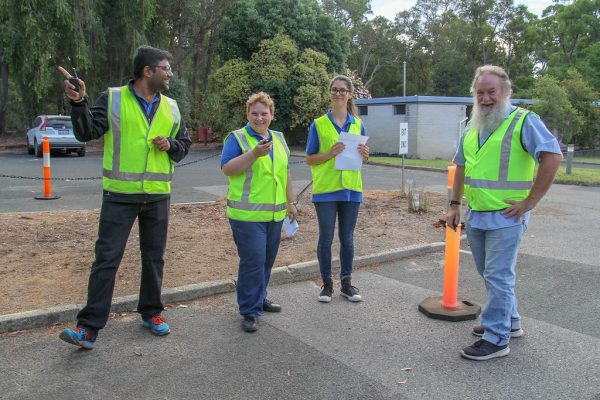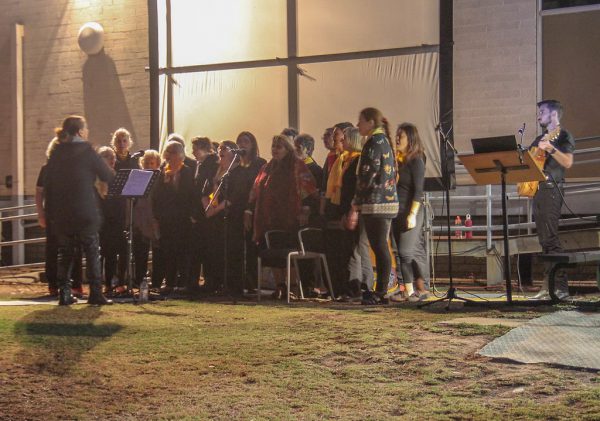The 2018 Summer Lecture

On the 16th of March, the Perth Observatory’s Summer Lecture hosted the renowned Parkes Observatory astronomer Dr Stacy Mader, as well as the Madjitil Moorna Aboriginal Choir and storytellers Bronwyn Goss and Aboriginal Cultural Leader Josie Wowalla Boyle.
Our audience of over 200 guests were taken on a cultural journey through time, space and history through the age-old practice of storytelling and its origins in the sky.
Upon arrival our guests were delighted to indulge in the history of the observatory, venturing into our very popular museum and Astroshop, before heading outside to our new amphitheatre.

As the Sun dipped below the horizon and the stars began to show, we were enthralled and entertained by the Madjitil Moorna Aboriginal Choir who led the night in a variety of cultural songs, both historic and written by the choir members. With words upon our projector screen our guest was encouraged to participate in song, and also s a bit of dancing as well.
As we all settled into the evening, with food and coffee from the local food trucks. Dr Mader began his lecture on the radio telescope at Parkes Observatory, made famous by the movie The Dish. But it wasn’t all about playing cricket on the scope as we delved into the amazing history of the observatory and the discoveries and collaborations Parkes, and Dr Mader has worked on. We learned that Parkes Observatory is NASA’s right-hand man, continuing to provide data on very significant missions. Dr Mader spoke fondly of working on projects such as the continuing communication with both Voyager 1 and Voyager 2 as they leave our solar system and having the 16 hours wait to receive and send data to Voyager 2, which will only get longer as the spacecraft continues to disappear into the depths of space

Dr Mader also tells about the famous 7 minutes of terror during the landing of the Mars rover Curiosity and how with NASA, they were both vital in receiving low and high-frequency radio signals. NASA receives High-Frequency radio signals and Parkes, low frequency. Each stage of the Curiosity landing and deployment had Mader and the astronomers at Parkes very nervously on the edge of their seats. What a relief that it was a successful mission. Parkes continues to correspond and receives signals from all three Mars rovers.
Dr Mader then moved onto talking about his aboriginal culture and their connection to the sky. How stories handed down among generations for hundreds of years have significance in how he himself studies the sky and similarities between the science and the stories. His people have a strong connection to the constellation Orion and the Pleiades. Dr Mader egressed his story of Naruang, who played fire games with Kamouda, the fire being the red glow from the star Betelgeuse. The story is about his culture’s initiation rites.

After Dr Mader answered some questions from the audience about light speeds and cultural interpretation we were treated to two cultural stories about the same constellation. Bronwyn Goss spoke a story of Greek mythology, about Orion pursuit for the seven sisters, his love and passion for them and the result of Orion forever in the sky facing the Pleiades. Aboriginal storyteller Josie Wowalla Boyle then told us the story of her culture told by her mother in the sand, taught to her by her grandmother before. Interestingly the stories run along with similar themes. The Pleiades again, representing sisters who are perused by hunters. In both stories, the faintest star of the Pleiades represent a sister that goes to a mortal man, and because of this, she wanders away from her sisters.

Knowing that these two stories had separate cultural origins and had come from different areas of the globe at different times in history show that we as humans connect with similar themes, similar values and interpretations. As Dr Mader says in his lecture, everyone is an astronomer. We have watched the sky for thousands of years and these old stories are recognised in the science community. These stories are physical, and they connect us all on a wonderful human level.
The stories carry layers, through history and time and it’s these similarities between the layers that connect us all.





